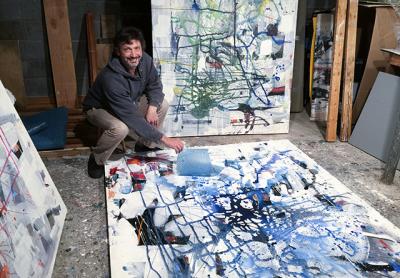Abstract Painting With a Photographer’s Eye

Until recently, Matt Vega’s deck was home to a giant 10-by-18-foot canvas on a stretcher, hooked on to the exterior of his house in Amagansett’s Devon Colony so the winds off the bay wouldn’t blow it away. “Xenotropic Panspermia” is a work in progress and a kind of magnum opus. He now has it rolled up in a 10-foot PVC pipe, where it will spend the winter. He’ll bring it out again in the spring.
The painting, which he began by pouring acrylics with the canvas placed flat on the ground, includes snippets of a visual language he has developed in the last few years. Its placement on a larger-than-life canvas seems a metaphor for his practice, the copious products of which include a studio filled with hundreds of stretched and unstretched paintings, bookcases full of sketchbooks, and boxes of photographs.
For a show last September, Mr. Vega and a friend took close to 100 paintings from a single series and “laid them out on the floor of Ashawagh Hall, trying to edit. It was quite a tedious task.”
Although he pursued figurative painting in college, he received his Yale M.F.A. in photography and practiced it prolifically and exclusively until 2012, pursuing networks of reeds, vines, and branches that often resembled abstract drawings or the work of Cy Twombly. “Regardless of how advanced my photography was getting, I realized I was being influenced and inspired by painting,” he said recently.
His early attempts channeled some of the energy and style of his favorite painters, including Twombly, Cezanne, and Philip Guston. Poetry and the street art of his youth in New York City inspired his “Word Paintings” series, which incorporate snippets of verse or entire poems into expressionistic lettering on stark or colorful backgrounds. Sometimes the letters stand out; sometimes they are obscured. “As a painter, I had always thought of myself as figurative, but that was not where I was going.”
“Imagined Landscapes,” which recall or interpret other artists’ painted landscapes, came next. Marked by square-ish strokes that distill Cezanne’s blocky abstractions of Mont Sainte-Victoire, these are not faithful renderings but pixelated sense memories. For those marks, Mr. Vega said he used a screwdriver. “You get a lot of energy without applying a lot of paint. There’s a lot of movement there.”
From there, he pursued still more abstraction. “I wanted to work on ideas from Cy Twombly without being too Cy Twombly. I had to let myself do some obvious things to get to the next phase.” He sometimes paints over his practice pieces or works he is dissatisfied with, first photographing them and often leaving traces of them in the new composition.
His compositions became refined into “Morphic Resonance,” a series inspired by his readings of the parapsychologist Rupert Sheldrake, who has defined the term as “the basis of memory in nature” and the “interconnections between organisms and of collective memories within species.” Although Mr. Vega uses the term specifically for this series, it carries over into the others. The “Imagined Landscapes,” for example, are his attempt to “channel information gathered from paintings I had seen, been impacted and influenced by, without referring directly to the paintings again,” to tap into “a kind of collective unconscious reservoir of the history of painting.”
The works are a purer version of the forms that came out of his denser abstractions. They are even further refined in the later “Dimorphism” series, which pairs objects that loosely resemble flora and fauna seemingly excavated from layers of paint. “The ‘Dimorphism’ series is about forms, organisms perhaps, which are related yet different, and the possibility of how those forms interact with one another as a result of, or in fact, because of those differences,” he said.
“Ordered Entropy” has elements of Jackson Pollock in its scale and dripped quality, but the paint application is far denser, with the bottom layers revealing daubs carried over from “Imagined Landscapes.” There is evidence of brush application and even the use of strings to apply paint. “I then plaster the string to the painting for texture.” He hopes the unorthodox use of applicators, including bubble wrap, will prompt the viewer to ask, “What am I looking at?”
He thought of bubble wrap, Mr. Vega said, while trying to figure out how to protect his outdoor painting from the elements. “I poured some paint on it while it was on the ground and then wrapped it, but the paint was still wet and the bubble wrap left marks. I liked it. Now I’m using it in other paintings.”
His latest abstractions leave more white space exposed, but still incorporate poured paint and string. The series is untitled as of now.
Mr. Vega was inspired to begin pouring paint by the work of the early color-field artist Morris Louis, but “I’m pouring with an urban-guerrilla mentality, pouring it on and making a mess of it, letting it do what it wants.” He sometimes uses a grout trowel for texture.
Those series pretty much account for all of Mr. Vega’s time spent on painting and the ideas he has percolating in his colossal outdoor canvas. From his earliest doodles to his purest abstractions, the work takes it all in. “I like the idea of asking the viewer to think, but only for the process of thinking, rather than a specific idea,” he said. “I want my paintings to elicit that.”
Click for the 2014 Matt Vega at Ille review
